Transition Defense - 5 Steps To Build a Great One | 2 Great Transition Drills | How to Defend Great Shooters In Transition
Winning coaches realize the importance of great 1/2 court defense. It is a focus in practice from the beginning of the season until the end. Coaches often focus on shell defense in practice, as well as breakdown drills in the halfcourt that help make their team very formidable in the half court setting.
And quite honestly, most teams work on their transition defense very little, so it is easy for offenses to score against them in transition.
It's time to stop neglecting your transition defense and here's why.....most team's number one and best option for scoring is their transition offense.
But What's Option #2 ?
Many teams want to run and try on their opponent before the defense gets set up. This is their primary option. Beat teams down the floor and get a good shot attempt before the opponent is prepared. If this is their primary scoring option, I want to see what Option #2 is from them. Oftentimes teams that are great in transition are not great in just a 1/2 court offense.
Making teams go to Option #2 is always part of my defensive strategy. Defensively I want to:
- Take away their best scorer and make them use option #2
- Make them go to option #2 (or 3) if when they are running a set
- If they are a team that loves to score in transition, make them use option #2 and set up their 1/2 court offense
Why would you ever let teams do what they do best? Make them use option #2!!
Thinking Like The Enemy
It always helps if you can put yourself in your opponent's shoes. How would you attack your defense? Have you built a solid and tough to score against defense? If so, how do teams beat you??
Whenever I coached against teams that had a great or even a good 1/2 court defense, we recognized the importance of attacking in transition before we had to face their 1/2 court defense. We wanted to emphasize our transition offense.
It usually meant easier shot attempts against a defense that was not prepared instead of facing a tough man to man defense in the 1/2 court setting.
To get FREE The Best 11 Defense Drills, click the banner below
5 Steps To Building A Transition Defense
Take the time to build out your transition defense, so your team has a firm understanding of what they need to do in transition to force teams to have to run their 1/2 court offense. Don't just hope your team plays well in transition, have a plan and prepare!
1 - Rotation Back:
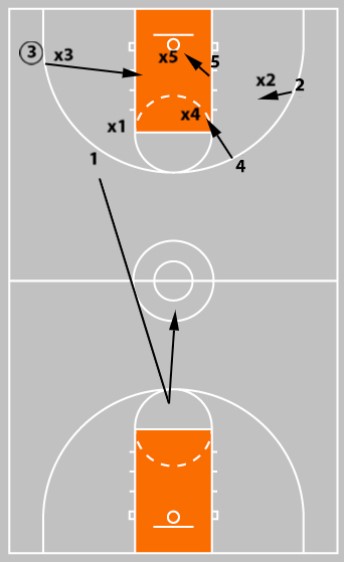
The first thing to decide is how many players you want to rotate back on an offensive shot attempt.
As the diagram shows, start by rotating one player back when the shot goes up. That means 4 offensive players can go to the glass.
You must also decide who on your team you want to rotate back. Do you want to rotate your 1-man back automatically every time? Do you want to rotate whoever is closest to the top of the key back each time?
Some things to consider:
- Is your 1-man a good offensive rebounder?
- Who rotates back when there is penetration.
If so, maybe you want to rotate someone else back instead of sending one of your better rebounders back. Always make adjustments based on your personnel.
Let's say you have your 1-man always rotating back. If the 1-man penetrates to the rim, you need someone else to rotate back on defense. Maybe it is the 2-man.....or maybe it is the wing is closest to the top of the key.
Make sure your players aren't GUESSING and they KNOW who rotates back.
Some coaches will choose to continue to play the same style of transition defense against every team. This could spell disaster for your team.
If you are playing a team that is extremely good in transition, but not so good in 1/2 court defense, then I recommend rotating 2 players back. As soon as the shot goes up, have 2 designated players sprinting back on defense immediately. This should guarantee no easy transition bucket.
Some teams will "leak" out 2 guards as soon as the shot goes up. Teams like this may require you to commit 3 players back. Don't be afraid to do this, if their strength is getting baskets in transition, take that away and see what else they can do!
2 - Crash → Turn & Burn:
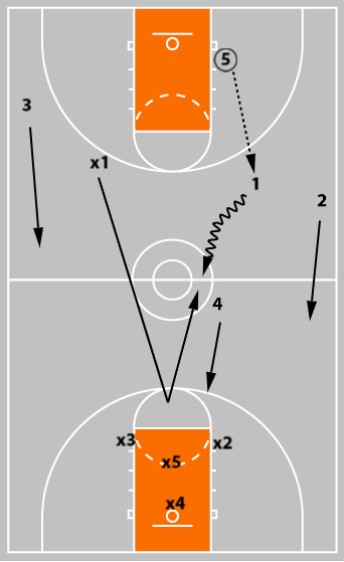
Good teams go to the offensive boards and come up with extra possessions. They flat out CRASH the boards HARD. Sometimes convincing players to go to the offensive glass can be easy for coaches. Players see this as an opportunity to get the ball and score.
The key is for offensive players to realize when the defense has secured the rebound and then commit to transition defense.
As soon as the defense secures the rebound they must immediately TURN & BURN to the other end.
Don't let players be lazy and hang around the player who got the rebound. They might be trying to slap it away or go for a steal. They are more valuable sprinting to the other end and helping their teammates play D.
I teach players to sprint and get a foot in the paint before they fan back out to match up. The 1-man protects the paint until teammates are back, then they go out to get the ball stopped.
Teams usually hurt you most in transition by attacking the rim - my first priority in defensive transition is to not give up a layup.
3 - Stop The Ball:
Coaches teach this in several different ways. Some coaches want the ball guarded as soon as it is in transition to the other end. Whether that be from an outlet pass or from a player getting the rebound and turning and dribbling down the court.
Some coaches want all their players to transition to the paint and let the ball come to them.
My approach to transition defense has always been to have the player that is not going to the offense boards (usually my 1-man) turn and sprint back to the top of the key.
My 1-man is my Floor General. They have several responsibilities in transition defense including:
- Making sure no one gets behind them.
They should be as deep as the deepest opponent, at least until a teammate gets to the paint. - Anticipating passes down the court.
- If everything in the paint is covered up, and the ball is being dribbled down the court, now it becomes the job of the 1-man to get the ball stopped.
The 1-man should be reading the eyes of the ball handler as well as the offense as they run down the court. Typically teams are taught to throw the ball ahead in transition.... and typically the player making the passes stares down the pass and makes this an easy read for the 1-man to pick off.
Take the time to build out your transition defense, so your team has a firm understanding of what they need to do in transition and force teams to have to run their 1/2 court offense.
Ideally they are stopping the ball early. I want my 1-man to get the ball picked up near 1/2 court if possible, which means after they retreat to the top of the key, they must sprint out under control to get the ball picked up.
4 - Defensive Positioning:
One of the most difficult pieces of transition defense to teach is proper positioning. As I mentioned earlier, in transition defense I teach players to sprint back to the paint to make sure the paint is covered up and there are no easy layups, post entries, or drives to the basket in transition.
Once this is taken care of, then players can worry about filtering out to the perimeter and finding their match up.
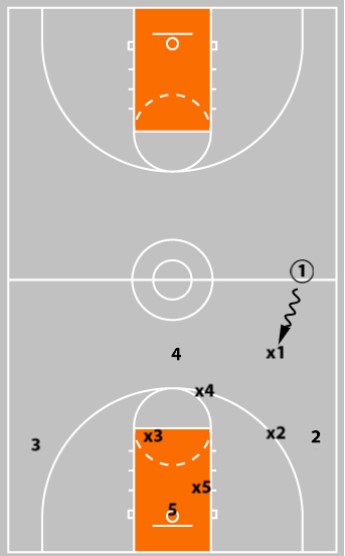
In the 1/2 court defensive setting, many coaches emphasize defensive positioning in relation to the ball. Emphasis is on where you should be if you are 1 or 2 passes away or your defensive positioning playing post defense.
Most players don't think or worry about defensive positioning until a team is running their 1/2 court offense. By then it might be too late. They likely have scored and you are trying to figure out exactly what went wrong.
As soon as your team has transitioned to the paint and taken away any easy shot, they should immediately be playing defense based on your 1/2 court rules. Assuming you are in man to man defense, players should position themselves accordingly.
For example in this diagram, as the ball is pushed down the floor on the right side, the defense on the opposite side of the floor should either be on the rim line playing help defense, or a minimum of a foot in the paint.
Oftentimes in transition, players will get guarded tight by their man, which opens up driving lanes and post options on the interior. As soon as the ball crosses 1/2 court, players must be positioning themselves based on where the ball is in relation to their man.
5 - Communication:
Most coaches realize the importance of good communication on the court. Teams that communicate well, usually are good on the defensive side of the ball. While communication is important in the 1/2 court setting, it is ABSOLUTELY CRUCIAL for good transition defense.
Think about the following transition situations in which communication is key:
- Communicating who is rotating back after your team shoots....especially if the player responsible for rotating back penetrates to the rim for a shot. There better be communication as to who now must rotate back instead.
- Your guard that rotates back must be good at communicating and where shooters are located.
- Communicating to your teammates as the ball comes into the 1/2 court is important. Letting the post know that they have help in the post or letting wings
know there is help on the drive.
Taking away the initial look in transition is crucial to making the offense pull the ball out and set up their offense. And that is a win for your transition D!
Their primary goal might be to stop the ball, but they are also the first one back and get a clear view as the offense comes down ready to attack. Communicating where the biggest offensive threat is located to teammates is imperative.
And by teaching man to man principles, you really don't have to change anything for your transition defense. The rules remain the same,
they are just applied to your transition defense.
Next...
We will show you 2 MUST HAVE transition drills to incorporate into your practices.
2 Great Drills For Transition Defense
If you have a problem with your transition defense, you need to incorporate drills to fix the problem.
Transition Neglect = Transition DISASTER
Don't neglect your transition defense in practice.
Sometimes coaches solely teach 1/2 court defense. Their idea of transition defense is telling their team to "get back". I promise you, this will lead to a disastrous season defensively.
Transition defense and your philosophy with it might be just as important or even more important at times than 1/2 court defense. Think about it. You may have a SPECTACULAR 1/2 court defense, but if you give up 16-20 points of off layups or easy shots in transition, then you will still struggle to win the game.
Whatever you do, make sure you have a plan. If you don't have a transition
defense plan, you are setting your team and players up for failure. Transition
defensive drills should be a part of your daily practice plans.
Tear Butt Transition Drill
This is a great drill that works on a lot of the pieces of building your transition defense.It also can be done at all levels. In this video Coach Huber demonstrates with a high school team, but I've used this drill with players from 3rd grade through college level.
This is a versatile drill. While normally done 4 v 4 or 5 v 5 , it can even be done 3 v 3.
Let's take a look at Coach Huber demonstrating the Tear Butt Drill
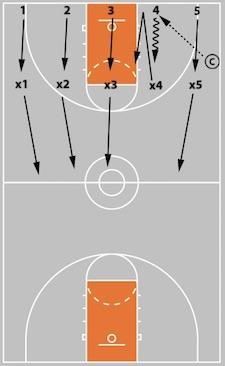
Instructions:
- Offense is on the baseline. Defense at the free throw line facing them.
- Coach throws the ball to an offensive player.
- The defender guarding the offensive player with the ball must sprint, touch the baseline, then spring back on defense.
- Everyone else is sprinting, head on a swivel, protecting the basket against the fast break.
- When the defense picks up the ball, have them push the ball to a side and match up to recover. This will allow the player hustling back to catch up to the play.
Variation - Call Out Name
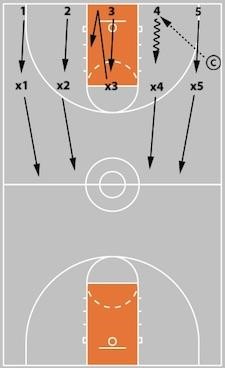
Here is another variation to give different looks and situations.
- Offense is on the baseline. Defense at the free throw line facing them.
- Coach throws the ball to an offensive player and calls out a random defensive player's name.
- The defensive player who was "called out" by the coach, must sprint down, touch the baseline and hustle back on defense.
This drill has a lot of flexibility. You can focus on different areas depending on the age of your players and what your team needs to work on. For example:
- A 4th grade team may simply focus on players sprinting back to the paint and then making sure there they don't get beat down the floor on defense.
- A Middle School team may focus on communication and getting the ball picked up by 1/2 court.
- High school teams may focus on communication and taking away 1 or 2 great 3 point shooters in transition.
Tailor this drill to meet YOUR TEAM'S needs in transition defense!
Whistle Drill
The Whistle Drill is a great drill that simulates the chaos that takes place during transition defense.
Transition defense is basically a scramble situation. Players should not worry about finding "their man" during transition. They should be worried about taking away the lane and easy baskets, stopping the ball, and identifying where the shooters are located.
The teams that...
- Communicate
- Anticipate
- Hustle
The Whistle Drill requires players to do all 3 of these things and therefore is a perfect drill to prepare your teams to successfully navigate the chaos of transition defense.
Below we have Coach Huber demonstrating the Whistle Drill.
Instructions:
- Have your team play 5-on-5 until you blow the whistle. You can decide to blow the whistle at any point.
- When the whistle is blown, the offensive player with the ball must set it down on the ground. The defender closest to the basketball can't pick it up, someone else on defense must pick up the ball.
- Once the ball is picked up, everyone must guard someone different from who was previously guarding them.
- Your team will continue to play 5-on-5, until you blow the whistle again. You can blow the whistle as frequently as you'd like.
The drill won't always look pretty. And that's OK.
Scramble situations and transition defense usually aren't pretty. But you are preparing your team to be effective at taking away easy baskets and finding the most dangerous scorers on the court in transition.
The more you practice these drills, the better your players will become at being decisive, communicating, and limiting easy buckets in transition.
Next....
In the next transition defense segment we will discuss how to take away GREAT
3 POINT SHOOTERS in the transition setting.
Transition Defense Versus Great Shooters
A common question I've heard from other coaches is "How do I take away the '3' in transition?' More and more teams are taking advantage of transition offense to get their best 3 point shooters good looks in transition.
More and more teams run their shooters to the corner or just let them spot up on the wing during transition. Make sure you prepare for this as well. As we prepare for an upcoming team. We will run the Tear Butt Drill, but each time we run the drill we designate one or two players on the baseline that are 3 point shooters that we CAN NOT give an open 3.
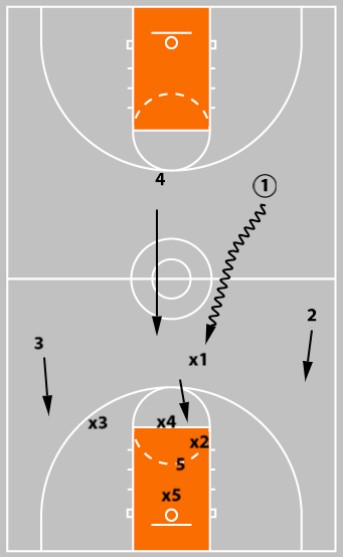
In this diagram I am pretending that the 3-man is a deadly 3 point shooter in transition. Therefore when matching up in transition with them, the defender is not covering up the paint first - they are stepping towards the shooter and allowing their teammates to take away the paint.
This may sound simple, but without practicing this in drills like Tear Butt Drill, players will not do this in the game. Players MUST rep this in order to do this in games.
Players are responsible for communicating and locating the 3 point shooters in transition and getting out to them immediately
As we transition back to defense, my 1-man who is the Floor General, should be helping out the team by pointing and identifying "shooter".
My wing who is closest to the shooter in transition is NOT responsible for covering up the paint first. They run toward the paint, but they make sure they can close out to the shooter without giving up a 3 point shot.
Plan And Be Flexible
Your transition defense will need to change and be flexible depending on the team you are playing.
The key is for you players to understand what you are trying to do in transition and the rules that you have installed for your transition defense.
From there, look at what teams are trying to do and make your adjustments to
take away their strengths!
Transition Offense & Defense
To learn more about building a defensive plan including transition, please check out Jim Huber's Man To Man Defense.
To get FREE The Best 11 Defense Drills, click the banner below
What do you think? Let us know by leaving your comments, suggestions, and questions...
|
|||||




 Facebook (145k Followers)
Facebook (145k Followers) YouTube (152k Subscribers)
YouTube (152k Subscribers) Twitter (33k Followers)
Twitter (33k Followers) Q&A Forum
Q&A Forum Podcasts
Podcasts